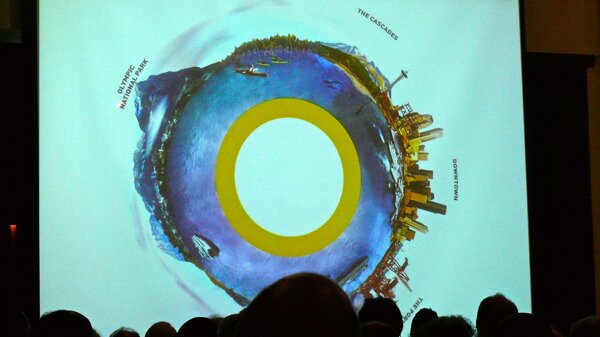
Last night landscape architect and urban designer James Corner and the waterfront project team held what was envisioned to be a smaller get-together, for people interested in the future of Seattle's waterfront, post-Viaduct. Over 1,100 people RSVP'd for the public meeting, held at the Aquarium, and video screens had to be set up throughout the building to allow the crowds to see Corner's presentation.
That photo, up top, captures the central metaphor that Field Operations is using, where Elliott Bay becomes an ideological circle, allowing a "psychological centering," as Corner put it. The waterfront becomes a balcony, overlooking the a "theatrical water body." (Our overdetermined waterfront was also described as a gateway, a seam, a juncture, a threshold, and a corridor.)
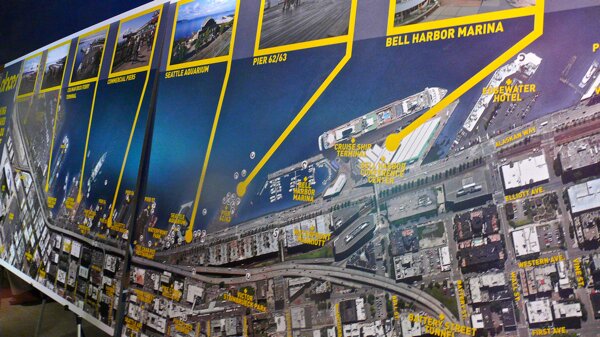
The team wants to know what Seattle thinks makes a great waterfront. If you visit the waterfrontseattle.org site, you can submit your answer online. At the Aquarium, a number of views of the waterfront were set up, to help get people into a musing frame of mind. Corner closed his talk with a burst of suggested uses--strolling, jogging, biking, shopping, swimming, climbing, sightseeing, playing--and asked in particular for things that would inspire regular usage, not simply an annual visit.
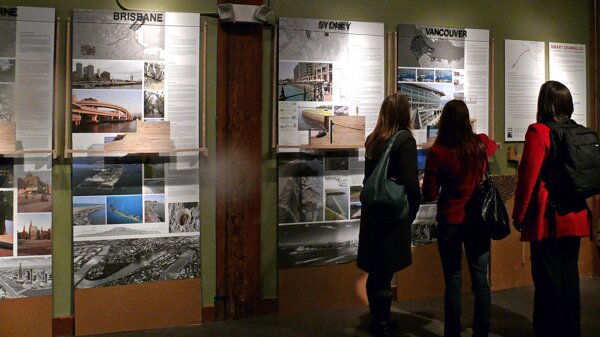
Part of the brainstorming involved this gallery, above, of how other waterfronts meet the needs of residents. During his talk, Corner cautioned that Seattle's waterfront is fairly thin, with smaller piers, so there's not a huge expanse to work with. Seattle's waterfront will have to "borrow" space from its surroundings, he said, and a good deal of his talk dealt with how the waterfront could be integrated into various sections of the city.
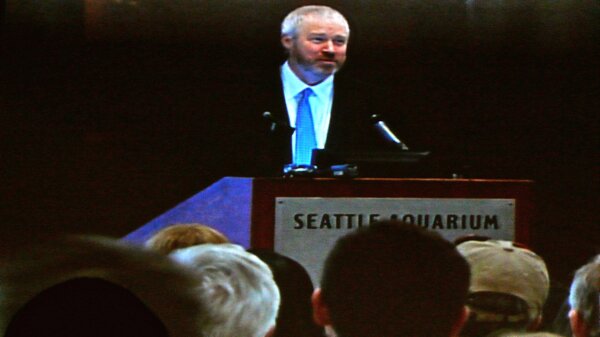
Mayor McGinn, fresh from vetoing the Council's agreement to proceed on the tunnel, used his opening remarks to discuss how unusual it is for a city to be decommissioning a highway, and what it means for Seattle. City Council members Nick Licata, Jean Godden, and Sally Bagshaw were also present. Bagshaw writes on her blog that she was delighted that Corner "is building on the work of our previous design charrettes held by the City and Allied Arts a number of years ago," and that he "understands the importance of our neighborhood connections, the waterfront businesses, the artistic and creative types, and those organizations including People for Puget Sound and Sound Keepers who have worked hard to clean up our waters." See also Bagshaw's vision for the waterfront.
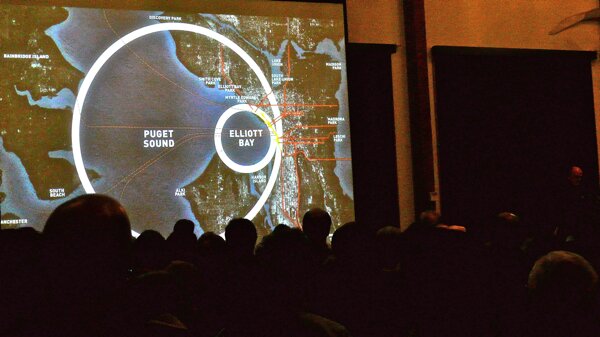
One of the themes of the night was that Seattle's waterfront is not simply a place but jumping off point and an entrance, thanks to the Port, the Ferry Terminal, and cruise lines. Corner's team had found one of Eric Fischer's Flickr dataset maps, showing what tourists and locals liked to visit and take pictures of. Corner's presentation, while avoiding design solutions at this early date, didn't shy away from ecological impacts (one slide considered the impact of stormwater runoff) or the physical challenges of reknitting the waterfront to the city's grid, thanks to abrupt terracing and even railway lines.
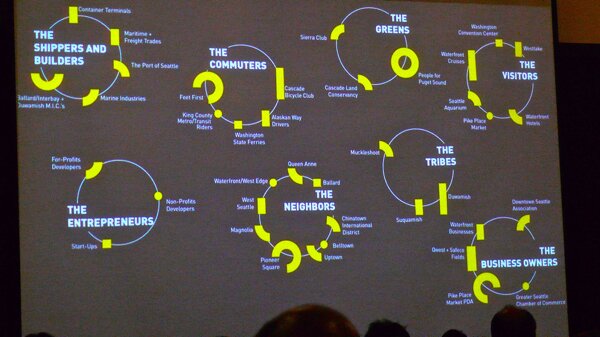
Another challenge considered in full was the array of "stakeholders with passionate interests." This slide has most, but not all, of the factions represented. Not listed, but mentioned, were the salmon that migrate past us. It is unusual, Corner reminded the crowd, that a city has such a strong identification with an iconic animal and its well-being as a species.
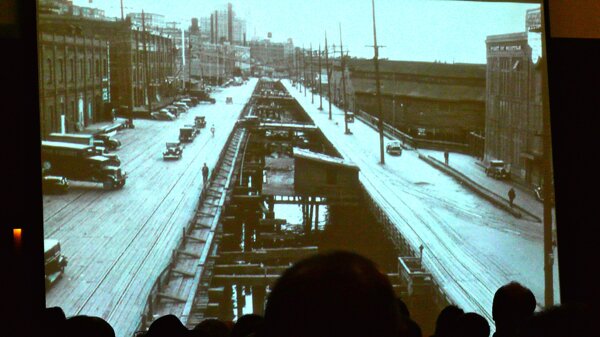
In discussing the seawall, Corner seemed struck by Seattle's historical attempts to coexist with Elliott Bay, the creation of an "engineered landscape" permeated by tidal flows, as in this early, pre-seawall picture depicting Seattle on stilts above tidal flats. Was it necessary, he asked, to think of the seawall as a single, linear barrier, or could it zigzag? (Prompting many of us in the audience to consider stopping in at the Zig Zag on the way home.) In any event, he pointed out, while it may be magical to think about being able to reach down and "touch the water," Seattle sees tides that can vary ten feet from low to high--a significant amount of water that can touch you back.
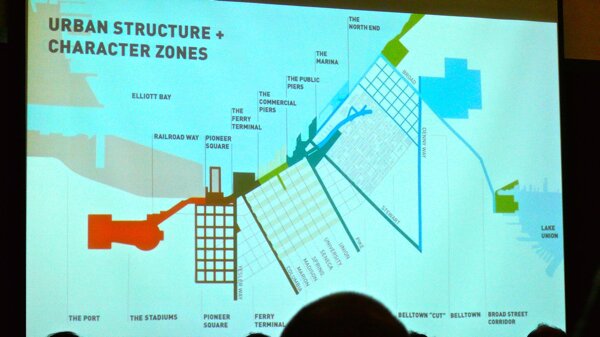
In detailing how their thinking had deepened with closer inspection of the site, Corner mentioned that their initial impression of a linear waterfront corridor had been subsumed by a realization that many different sections of the city, from the Port at the south to Belltown at the north, each had different relationships with the waterfront. On the one hand, there's the broad brush of the skyline, envisioning how all these buildings with their "backs" to the Viaduct will now have the chance to open themselves to an amazing view (this is where the balcony notion comes from, and the "apron" of the piers). But on the other hand, the physical connections to the waterfront vary wildly as you move along, from flat and steep streets to abrupt bluffs and stair climbs.
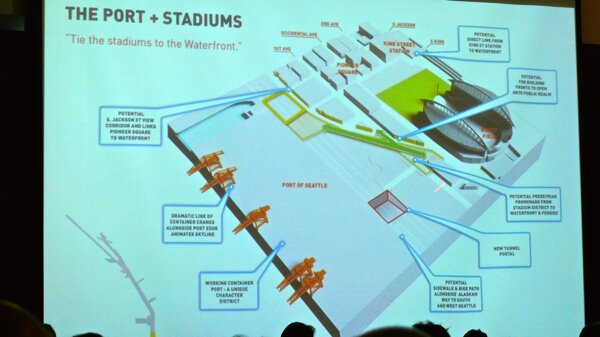
"I love the cranes," said Corner. "They're haunting artifacts." He worked his way along from south to north, discussing ways to tie existing parcels to the waterfront, to integrate them. There's the "potentially vibrant" Pioneer Square, a Jackson Street view corridor, the gateway of the Marion Street bridge--and if a section of the Viaduct is to be retained for park use, perhaps at the Seneca Street ramp? Access from Union Street, he noted drily, could be "more user friendly." Maybe pedestrian walkways could lead from Victor Steinbrueck Park to the Aquarium, and from the Pike Place Market to Piers 62 and 63.
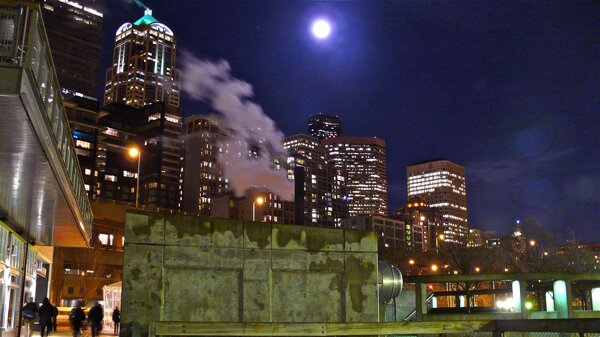
In summing up, Corner argued that the waterfront is not simply about the idea of a park, but about the idea of a city. In replacing a highway with this kind of public space, Seattle has the chance to increase residential life on the waterfront, to replace the need to drive with inhabitants that will keep the public space dynamic all year 'round. Is there a way, he asked, to meld a Dutch, "brash" approach with something that's also intelligent and fine-grained? Again, your thoughts are requested at waterfrontseattle.org.
Personally, I was struck by the idea of heated saltwater baths. If you want to drag me down to the waterfront all year long, there'd better be something warm and relaxing nine months of the year.
 Subscribe to our Front Page Stories
Subscribe to our Front Page Stories
![]() Subscribe to all SunBreak Stories
Subscribe to all SunBreak Stories

Most Recent Comments